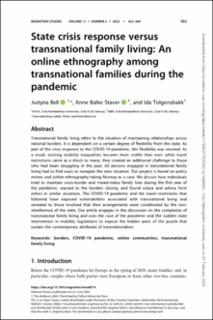| dc.contributor.author | Bell, Justyna | |
| dc.contributor.author | Staver, Anne Balke | |
| dc.contributor.author | Tolgensbakk, Ida | |
| dc.date.accessioned | 2024-02-08T07:01:53Z | |
| dc.date.available | 2024-02-08T07:01:53Z | |
| dc.date.created | 2023-06-23T11:03:18Z | |
| dc.date.issued | 2023 | |
| dc.identifier.citation | Migration Studies. 2023, 11 (3), 452-469. | en_US |
| dc.identifier.issn | 2049-5838 | |
| dc.identifier.uri | https://hdl.handle.net/11250/3116271 | |
| dc.description.abstract | Transnational family living refers to the situation of maintaining relationships across national borders. It is dependent on a certain degree of flexibility from the state. As part of the crisis response to the COVID-19 pandemic, this flexibility was revoked. As a result, existing mobility inequalities became more visible than ever: while travel restrictions came as a shock to many, they created an additional challenge to those who had been struggling in the past. All persons engaged in transnational family living had to find ways to navigate the new situation. Our project is based on policy review and online ethnography taking Norway as a case. We discuss how individuals tried to maintain cross-border and mixed-status family lives during the first year of the pandemic, reacted to the borders closing, and found solace and advice from others in similar situations. The COVID-19 pandemic and the travel restrictions that followed have exposed vulnerabilities associated with transnational living and revealed to those involved that their arrangements were conditioned by the non-interference of the state. Our article engages in the discussion on the complexity of transnational family living and uses the case of the pandemic and the sudden state intervention in mobility regulations to expose the hidden parts of the puzzle that sustain the contemporary attributes of transnationalism. | en_US |
| dc.language.iso | eng | en_US |
| dc.rights | Attribution-NonCommercial-NoDerivatives 4.0 Internasjonal | * |
| dc.rights.uri | http://creativecommons.org/licenses/by-nc-nd/4.0/deed.no | * |
| dc.subject | Sosiale medier | en_US |
| dc.subject | Social media | en_US |
| dc.subject | Koronapandemi | en_US |
| dc.subject | coronary pandemic | en_US |
| dc.subject | Transnasjonalitet | en_US |
| dc.subject | Transnationality | en_US |
| dc.title | State crisis response versus transnational family living: An online ethnography among transnational families during the pandemic | en_US |
| dc.type | Peer reviewed | en_US |
| dc.type | Journal article | en_US |
| dc.description.version | publishedVersion | en_US |
| cristin.ispublished | true | |
| cristin.fulltext | original | |
| cristin.qualitycode | 1 | |
| dc.identifier.doi | 10.1093/migration/mnad014 | |
| dc.identifier.cristin | 2157389 | |
| dc.source.journal | Migration Studies | en_US |
| dc.source.volume | 11 | en_US |
| dc.source.issue | 3 | en_US |
| dc.source.pagenumber | 452-469 | en_US |
| dc.subject.nsi | VDP::Statsvitenskap og organisasjonsteori: 240 | en_US |
| dc.subject.nsi | VDP::Political science and organisational theory: 240 | en_US |
| dc.subject.nsi | VDP::Statsvitenskap og organisasjonsteori: 240 | en_US |
| dc.subject.nsi | VDP::Political science and organisational theory: 240 | en_US |

